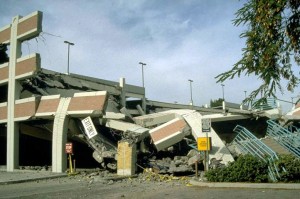
Parking structure on CSU-Northridge campus. 1994 Northridge Earthquake
Northridge 20 Symposium Brings Together Earthquake Experts to Improve Statewide Built Environment
Read the Summary Report (5.7 MB PDF)
2014 is the twentieth anniversary of the January 17, 1994 Northridge earthquake
(M= 6.7 ; Los Angeles, CA ; 4:31 A.M.) that resulted in 57 deaths, thousands injured, and over $20 billion in direct damage. The event spurred important changes to the current practice of earthquake engineering and risk mitigation worldwide, including changes to building codes for steel structures and multi-unit wooden buildings, re-examination of near-field and basin effects for seismic sources, and radical modifications to the risk assessment and insurance sectors.
By bringing together policy makers, government officials, building officials, engineers, earth scientists, emergency managers, building owners, neighborhood and community leaders, and financial services industry professionals, Northridge 20 shared the impacts of the 1994 earthquake, highlighted accomplishments of the past two decades to better understand and reduce earthquake risks, and identified necessary steps forward to make our communities more resilient to future earthquakes.
Northridge 20 opened on Thursday, January 16, 2014 with a multidisciplinary plenary session, “Northridge Earthquake: Impacts, Outcomes, Next Steps,” and continued on Friday, January 17, 2014 with concurrent technical and educational sessions on a wide variety of related topics. The symposium was held at the University of California, Los Angeles.
Participating organizations included Applied Technology Council, the American Institute of Steel Construction, California Earthquake Authority, California Governor’s Office of Emergency Services (Cal OES), the California Seismic Safety Commission, Caltrans, City of LA Department of Building and Safety (LADBS), CVSIC, Earthquake Engineering Research Institute, Federal Alliance for Safe Homes (FLASH), Federal Emergency Management Agency (FEMA), Los Angeles Tall Building Structural Design Council (LATBSDC), NEES, Pacific Earthquake Engineering Research Center (PEER), RenaissanceRe Risk Sciences Foundation, Southern California Earthquake Center (SCEC), the Structural Engineers Association of Southern California (SEAOSC), University of California, Los Angeles, the United States Geological Survey, and the Western States Seismic Policy Council.








